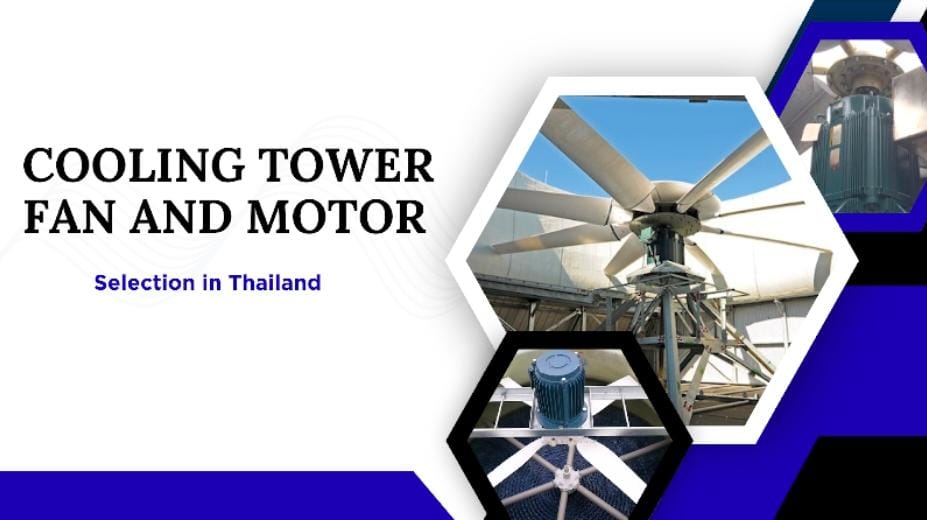Cooling Tower Fan and Motor Selection in Thailand

Thailand’s industrial landscape relies heavily on cooling towers to combat the nation’s intense heat and humidity. From manufacturing plants in Bangkok to power generation facilities across the country, these systems work around the clock to maintain optimal operating temperatures.
The fan and motor represent the heart of any cooling tower system, consuming up to 90% of the tower’s total energy requirements. This makes their selection a strategic decision that directly impacts both operational efficiency and long-term costs.
For industries operating in Thailand’s challenging climate, where ambient temperatures regularly exceed 35°C and humidity levels remain consistently high, the stakes are even higher.
The thermal performance of cooling towers depends entirely on effective airflow management. Without proper air circulation, even the most advanced fill media and water distribution systems cannot deliver optimal cooling.
This is where expert guidance becomes invaluable. Partnering with specialists in Cooling Tower Thailand ensures that facility managers receive tailored recommendations based on local conditions, regulatory requirements, and industry best practices.
Table of Contents
- Introduction
- Understanding the Airflow Imperative: Fan Types and Their Role
- The Core Function of Cooling Tower Fans
- Types of Cooling Tower Fans Common in Thailand
- Axial Flow Fans
- Centrifugal Fans
- Key Fan Performance Metrics to Consider
- Motor Selection for Peak Performance & Efficiency
- The Crucial Role of the Cooling Tower Motor
- Motor Types and Drive Systems for Cooling Towers
- Standard Induction Motors
- Energy-Efficient Motors (IE3/IE4/IE5)
- Direct Drive Motors
- Gearbox Drive Systems
- Crucial Selection Considerations for Thailand’s Unique Environment
- The Selection Process: A Step-by-Step Guide for Thai Industries
- Define Cooling Requirements
- Assess Site Conditions
- Evaluate Fan and Motor Options
- Conduct a Lifecycle Cost Analysis (LCCA)
- Partner with Local Experts
- Conclusion
- FAQs
Understanding the Airflow Imperative: Fan Types and Their Role
The Core Function of Cooling Tower Fans
Cooling tower fans serve a fundamental purpose: they create the airflow necessary for evaporative cooling. By drawing or pushing air through the fill media, fans facilitate the heat transfer process that removes thermal energy from the circulating water. This airflow creates the pressure differential needed to maximize the contact between air and water, enabling efficient evaporation and cooling.
Types of Cooling Tower Fans Common in Thailand
Axial Flow Fans
Induced Draft systems position the fan at the top of the cooling tower, pulling air upward through the fill media. These configurations offer several advantages in Thailand’s climate:
- Uniform airflow distribution prevents hot spots
- Reduced air recirculation minimizes efficiency losses
- Quieter operation at ground level suits urban installations
- Better protection from weather elements
Forced Draft systems place the fan at the base, pushing air upward through the tower. While less common in new installations, they provide specific benefits:
- Easier maintenance access reduces service costs
- Lower static pressure requirements improve energy efficiency
- Simple mechanical design enhances reliability
Centrifugal Fans
Though less common in standard cooling tower applications, centrifugal fans excel in specialized installations. These systems work well when:
- High static pressure conditions exist
- Ducted air systems require integration
- Space constraints limit axial fan installation
- Noise reduction is paramount
Key Fan Performance Metrics to Consider
Understanding fan performance requires evaluating multiple interconnected factors. How do these metrics translate to real-world efficiency gains?
- Air Volume (CFM/m³/s): Determines the cooling tower’s heat rejection capacity and directly affects thermal performance
- Static Pressure: Influences energy consumption and must match the tower’s resistance characteristics
- Fan Horsepower/kW: Indicates the power required to achieve desired airflow rates
- Fan Efficiency: Measures how effectively the fan converts motor power into useful airflow
- Noise Levels: Critical for compliance with Thailand’s environmental regulations and community relations
Motor Selection for Peak Performance & Efficiency
The Crucial Role of the Cooling Tower Motor
The motor transforms electrical energy into mechanical energy that drives the fan system. Motor selection directly impacts energy consumption, maintenance requirements, and overall system reliability. In Thailand’s industrial sector, where electricity costs continue rising and energy efficiency regulations become stricter, motor choice represents a significant operational decision.
Motor Types and Drive Systems for Cooling Towers
Standard Induction Motors
Traditional three-phase induction motors have historically powered most cooling tower installations. While reliable and cost-effective initially, they lack the efficiency standards required for modern energy conservation goals.
Energy-Efficient Motors (IE3/IE4/IE5)
International Efficiency (IE) classifications define motor performance standards globally. What makes these motors essential for Thai installations?
- IE3 Motors: Provide 15-25% efficiency improvement over standard motors
- IE4 Motors: Achieve premium efficiency levels with advanced magnetic materials
- IE5 Motors: Represent the highest efficiency category with permanent magnet technology
Despite higher initial costs, energy-efficient motors deliver substantial savings through reduced electricity consumption. Thailand’s Department of Alternative Energy Development and Efficiency (DEDE) actively promotes these technologies through incentive programs.
Direct Drive Motors (Permanent Magnet Motors)
Direct drive systems eliminate the gearbox, connecting the motor directly to the fan. This configuration offers compelling advantages:
- Elimination of mechanical losses improves overall efficiency
- Reduced maintenance requirements lower operating costs
- Quieter operation meets strict noise regulations
- Compact design simplifies installation
Gearbox Drive Systems
Traditional gearbox systems remain common in existing installations. Key considerations include:
- Regular lubrication requirements increase maintenance costs
- Mechanical losses reduce overall system efficiency
- Potential for gear wear creates reliability concerns
Crucial Selection Considerations for Thailand’s Unique Environment
Climate and Environmental Factors
Thailand’s tropical climate presents unique challenges that directly impact fan and motor selection. How do these conditions affect equipment performance and longevity?
- High Ambient Temperatures: Consistently elevated temperatures increase cooling loads and affect motor cooling requirements
- Extreme Humidity: Moisture levels demand motors with appropriate IP ratings (IP55 minimum for outdoor installations)
- Corrosion Resistance: Coastal locations and industrial environments require specialized coatings and materials
- Seasonal Variations: Monsoon conditions create additional moisture and contamination challenges
Energy Efficiency Regulations in Thailand
Thailand’s energy policy framework increasingly emphasizes industrial efficiency. The government’s 20-year Energy Efficiency Development Plan targets significant reductions in energy intensity across all sectors. Industries investing in high-efficiency cooling tower systems can benefit from:
- Tax incentives for energy-efficient equipment
- Accelerated depreciation schedules
- Recognition in corporate sustainability programs
Noise Pollution Control
Urban cooling tower installations must comply with Thailand’s noise control regulations. Effective noise management strategies include using soundproof enclosures, low-noise fans, and vibration dampers to minimize disturbances.
- Low-noise fan blade designs
- Variable frequency drives (VFDs) for speed control
- Sound attenuators and barriers
- Strategic placement away from sensitive areas
Reliability and Maintainability
Thailand’s industrial environment demands robust, maintainable equipment. Critical factors include durability to withstand challenging conditions, energy efficiency to reduce operational costs, and compliance with environmental regulations to ensure sustainable practices.
- Local availability of spare parts and service expertise
- Resistance to tropical conditions and contamination
- Accessibility for routine maintenance and repairs
- Long-term support from manufacturers and distributors
The Selection Process: A Step-by-Step Guide for Thai Industries
Define Cooling Requirements
Accurate cooling load calculations form the foundation of proper fan and motor selection. Essential parameters include:
- Heat rejection capacity requirements
- Water flow rates and temperature differentials
- Seasonal load variations
- Future expansion considerations
Assess Site Conditions
Site-specific factors significantly influence equipment selection. What environmental and operational constraints must be considered?
- Space Limitations: Available area affects fan size and motor configuration options
- Noise Constraints: Proximity to residential areas or offices limits acceptable sound levels
- Power Availability: Electrical supply characteristics determine motor voltage and starting requirements
- Access Requirements: Maintenance accessibility influences drive system selection
Evaluate Fan and Motor Options
Comprehensive evaluation requires analyzing multiple performance factors simultaneously. Compare options based on:
- Performance curves and efficiency ratings
- Initial purchase costs and installation requirements
- Operating costs including energy consumption
- Maintenance requirements and expected service life
Conduct a Lifecycle Cost Analysis (LCCA)
Lifecycle cost analysis provides the most accurate basis for equipment selection. Why is LCCA particularly important for cooling tower applications?
- Energy Costs: Represent 80-90% of total ownership costs over equipment life
- Maintenance Expenses: Vary significantly between different motor and drive technologies
- Replacement Timing: Efficient systems often justify longer replacement cycles
- Productivity Impact: Reliable systems reduce costly downtime and production losses
Partner with Local Experts
Successful cooling tower projects require a deep understanding of local conditions, regulations, and market dynamics. Skilled cooling tower experts in Thailand bring unmatched knowledge and specialized experience in:
- Climate-specific equipment recommendations
- Regulatory compliance and permitting
- Local supplier networks and service support
- Performance optimization and troubleshooting
Conclusion
In Thailand’s demanding industrial climate, optimal Cooling Tower Fan and Motor Selection is far more than a technical detail; it’s a strategic investment. We’ve seen how choosing the right fan type, coupled with energy-efficient motors and smart drive systems like VFDs, directly impacts your operational efficiency and bottom line.
Work with local specialists, and you’ll nail that perfect cooling performance, dramatically reduce electricity use, and build a truly reliable, sustainable foundation for your business’s profitability for years to come. This commitment builds a foundation for long-term profitability and environmental responsibility.
FAQs
How do VFDs save energy in cooling towers?
Variable frequency drives (VFDs) adjust fan speed to align perfectly with cooling needs, eliminating the inefficiency of running at full speed unnecessarily. This significantly cuts energy consumption and extends motor lifespan, especially during partial loads.
How to reduce cooling tower noise in urban Thailand?
Use low-noise fan designs, VFDs for speed control, and sound attenuators or barriers. Strategic placement away from sensitive areas also significantly helps.
Are IE3/IE4/IE5 motors worth the cost in Thailand?
Yes, absolutely. Despite higher upfront costs, these energy-efficient motors offer substantial long-term savings on electricity bills, making them highly cost-effective in Thailand’s energy landscape.
Why is LCCA vital for fan or motor selection?
Lifecycle Cost Analysis provides the full financial picture, including initial cost, major energy expenses, and maintenance over the equipment’s lifetime. It ensures the most cost-effective long-term decision.
